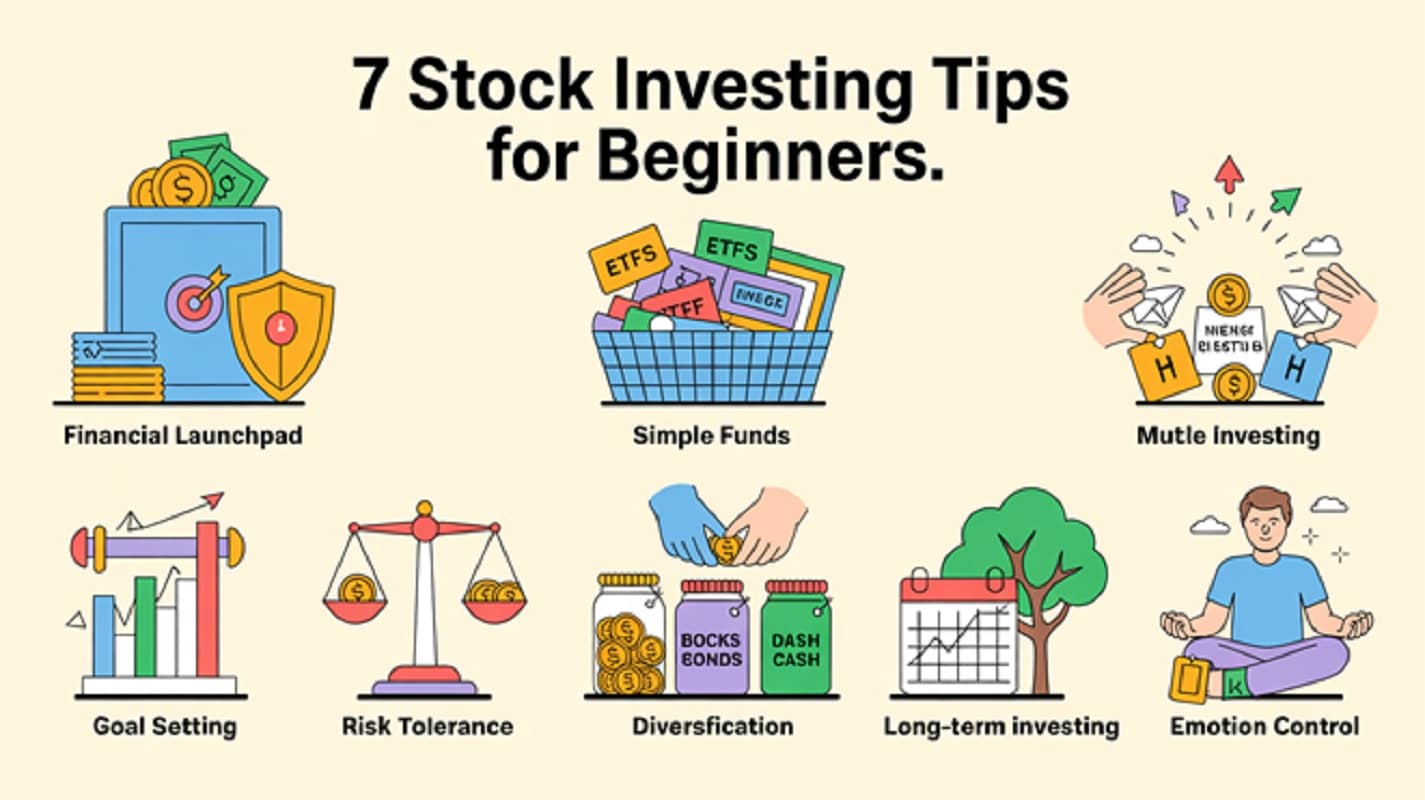So, the idea of investing in the stock market has caught your attention? That’s fantastic! It’s a powerful way to potentially build wealth over time. But let’s be honest, it can also feel a bit like stepping into a vast, unknown territory. Maybe thoughts like “Isn’t it really risky?” or “Where do I even begin?” or “Will I lose all my money?” are swirling around. Those feelings are completely normal. Many beginners feel a mix of excitement and apprehension.
The good news is, getting started doesn’t have to be overly complicated or terrifying. Forget the images of frantic traders shouting on Wall Street; successful investing for most people is about steady progress, not overnight riches. This guide is here to cut through the noise and hype, breaking down the essentials into 7 practical tips. Think of these as the foundational building blocks for a solid, long-term investing journey. We’ll walk through this together, step by step, focusing on sound principles to help build confidence along the way.
Tip 1: Build Your Financial Launchpad First
Before jumping into stocks, ensure your financial foundation is solid. Investing comes after immediate financial health.
First, build an emergency fund: 3 to 6 months of essential living expenses (rent, food, utilities) in an easily accessible savings account. Life throws curveballs (job loss, medical bills). Without this safety net, you might be forced to sell investments at a bad time, locking in losses.
Next, tackle high-interest debt, like credit cards (often 15%+ interest). Paying off 20% interest debt gives a guaranteed 20% return – hard to beat consistently with investing. High-interest debt is like a leak; plug it before pouring investment money in.
This isn’t just good finance; it’s crucial risk management for investing. Investing involves market risk. High-interest debt is a certain drain, and no emergency fund creates liquidity risk (needing cash fast and selling low). Addressing these first builds resilience for market ups and downs.
Tip 2: Know Your Destination: Set Clear Investing Goals
Investing without goals is like driving aimlessly. Define why you’re investing. What’s the money for?
Goals provide purpose and motivation, especially during market dips. Categorize goals by time horizon:
- Short-Term (1-3 years): Vacation, car down payment. Strategy: Preserve capital, easy access (savings accounts, short-term CDs).
- Medium-Term (3-10 years): House down payment, near-term education. Strategy: Balance preservation and growth (bonds, CDs, maybe some less volatile stock funds).
- Long-Term (10+ years): Retirement, future education. Strategy: Growth-oriented, ride out fluctuations (higher allocation to stocks/stock funds).
Use the SMART framework: Specific, Measurable, Achievable, Relevant, Time-bound. Instead of “save for retirement,” try: “Accumulate $1 million for retirement by age 65 by investing $500/month”.
Setting goals determines your strategy, risk level, and asset allocation. The goal dictates the time horizon. Time horizon influences risk tolerance (how much risk you can handle). Risk tolerance guides your asset mix (stocks vs. bonds). Without a clear goal, investing lacks a rational foundation.

Tip 3: Understand Your Comfort Zone: Assess Your Risk Tolerance
Investing involves risk – the chance returns differ from expectations, including potential loss. Understand your risk tolerance: how much fluctuation you can handle emotionally without making rash decisions (like panic selling).
Factors influencing risk tolerance:
- Time Horizon: Longer time = potentially higher tolerance.
- Financial Situation (Risk Capacity): Stable income, savings, low debt = higher ability to take risk.
- Goals & Reliance on Funds: Critical near-term goal = low tolerance.
- Personality & Emotional Reaction (Risk Composure): Natural comfort with uncertainty.
Understanding risk tolerance informs investment choices and asset allocation (mix of stocks, bonds, cash). A mismatch causes problems: too much risk leads to panic selling; too little means missing growth.
Assess honestly: “How would I feel if my portfolio dropped 20%?” Questionnaires help, but self-reflection is key. Risk tolerance can change.
Consider three aspects :
- Risk Capacity: Ability to take risk (financials).
- Risk Tolerance: Willingness to take risk (comfort).
- Risk Composure: Emotional ability to handle volatility. A realistic assessment considers all three.
|
Risk Tolerance Level |
Description |
Sample Allocation |
| Conservative | Prioritizes stability; accepts lowest returns for minimal fluctuation. | 10-30% / 60-80% / 10% |
| Moderately Conservative | Seeks income/stability, modest growth; accepts low fluctuation. | 30-50% / 40-60% / 10% |
| Moderate | Balances growth/preservation; accepts moderate fluctuation. | 50-70% / 30-50% / 0-5% |
| Moderately Aggressive | Seeks good growth; accepts high fluctuation/potential loss. | 70-90% / 10-30% / 0-5% |
| Aggressive | Seeks highest growth; accepts substantial volatility/potential loss. | 85-100% / 0-15% / 0% |
Tip 4: Keep It Simple: Favor Funds Over Single Stocks (Initially)
Picking the “next big stock” isn’t necessary for beginners. Starting with funds (mutual funds or ETFs) is often simpler and more effective.
An individual stock is ownership in one company. Funds pool money to buy a basket of many investments (stocks, bonds).
Why funds for beginners?
- Instant Diversification: One fund share gives exposure to many holdings, cushioning the impact if one holding does poorly. Single stocks are riskier.
- Simplicity: Funds offer pre-packaged diversification, saving the time/effort of researching many individual stocks.
- Low Cost (Index Funds/ETFs): Many index funds and ETFs tracking market indexes (like S&P 500) have very low fees (expense ratios).
Starting with a broad-market index fund or ETF is often sensible.
Choosing funds initially manages investment risk and the learning curve. It simplifies decisions, allowing focus on core principles (goals, risk, consistency, discipline) while getting money working. Individual stock picking can come later.
Tip 5: Spread Your Bets: Diversify Your Investments
“Don’t put all your eggs in one basket” is crucial investing wisdom. Diversification means spreading investments across categories so weakness in one area doesn’t sink the portfolio.
Diversify on multiple levels:
- Across Asset Classes: Mix stocks, bonds, cash. They often react differently to events, smoothing returns.
- Within Stocks: Spread across :
- Company Sizes: Large-cap, mid-cap, small-cap.
- Sectors/Industries: Tech, healthcare, finance, etc.. Avoids overexposure if one industry struggles.
- Geographies: Domestic and international (developed/emerging markets). Taps into different economic cycles.
- Within Bonds: Diversify by :
- Issuer Type: Government, municipal, corporate.
- Credit Quality: Investment-grade vs. high-yield (higher yield = higher risk).
- Maturity: Short-, intermediate-, long-term.
The goal is risk management – smoothing volatility and protecting against big losses. This makes it easier psychologically to stay invested.
For beginners, mutual funds and ETFs are the most practical way to achieve broad diversification.
Effective diversification isn’t just owning many things, but different kinds of things likely to behave differently (low correlation). Owning ten tech stocks isn’t true diversification if the whole sector falls. Combine assets like stocks and bonds, or US and international stocks, that don’t move in lockstep.
Tip 6: Play the Long Game: Invest for the Long Haul
Successful investing is usually a marathon, not a sprint. Adopt a long-term perspective; focus on “time in the market,” not “timing the market”.
Why long-term works:
- Compounding: Returns generate their own returns, leading to potential exponential growth over time. Starting early gives compounding more time.
- Historical Market Trends: Markets tend upward long-term, overcoming short-term crises. Holding diversified portfolios (like S&P 500) for 20+ years has historically yielded positive returns.
- Market Timing is Futile: Consistently buying low/selling high is nearly impossible. Trying often means missing the market’s best days, drastically reducing returns.
- Lower Costs/Taxes: Buy-and-hold means fewer transactions (lower fees) and potentially lower long-term capital gains taxes (vs. higher short-term rates).
- Riding Out Volatility: A long view helps weather market storms. Short-term swings are normal; the long-term growth trend has historically prevailed.
Dollar-Cost Averaging (DCA) fits well: invest fixed amounts regularly, buying more shares when prices are low, fewer when high.
A long-term mindset provides resilience. It reframes volatility as expected turbulence. Strategies like buy-and-hold and DCA reduce emotional decision-making. Focusing on controllable actions (saving, staying invested) builds emotional fortitude.
Tip 7: Keep Calm and Carry On: Master Your Investing Emotions
Warren Buffett noted success requires controlling urges that get others into trouble. Often, the biggest hurdle isn’t picking wrong, but letting emotions dictate decisions.
Common emotional pitfalls :
- Fear & Panic: Leads to panic selling during downturns, locking in losses.
- Greed & FOMO: Leads to chasing performance, buying hyped stocks at high prices.
- Overconfidence: Leads to excessive risk-taking after early successes.
- Loss Aversion: Holding losers too long, hoping they’ll recover.
- Herd Mentality: Following the crowd without independent analysis.
How to manage emotions:
- Have a Plan and Stick to It: Your anchor based on goals, risk tolerance, diversification, and long-term view. Write it down.
- Automate Investing: Regular contributions (DCA) remove emotional decision points.
- Limit Noise: Constant portfolio checking/sensational news fuels fear/greed.
- Keep an Investing Journal: Track decisions, reasoning, and emotions to identify triggers.
- Focus on What You Can Control: Savings rate, plan, diversification, reactions.
- Practice Mindfulness: Acknowledge emotions, pause before acting.
Mastering emotions isn’t about suppression, but creating a structured process (plan, automation, journaling) that guides behavior despite emotions.
Conclusion
Starting your investment journey can be incredibly rewarding. While it seems complex, these seven tips provide a solid foundation: build your financial launchpad, set clear goals, know your risk tolerance, start simple with funds, diversify, play the long game, and manage emotions.
Starting small is fine; learn as you go. Investing success is measured in years, not weeks. Patience, discipline, and a long-term focus are key. Apply these principles to work steadily towards your financial goals.
Frequently Asked Questions (FAQ)
Here are answers to some common questions beginners have about getting started with stock investing.
What’s the absolute minimum I need to start investing?
Thanks to competition among brokerages, many now have no account minimums. Furthermore, the availability of fractional shares means investors can often buy portions of stocks or ETFs for as little as $1 or $5, depending on the broker. So, practically speaking, one can start investing with very small amounts today.
Should I pay off my student loans/mortgage before investing?
It depends on the interest rate. Financial planners typically advise prioritizing the payoff of high-interest debt (like credit cards, often 15-25%+) before investing, as the guaranteed return from debt elimination usually exceeds potential investment gains. For lower-interest debt (like federal student loans or mortgages, often below 6-8%), the decision is more nuanced. Some may choose to invest while paying these off, aiming for long-term investment returns higher than the debt interest rate, while others prefer being debt-free first. Consider the interest rate, tax implications, and personal comfort level.
What’s the difference between a stock and a bond?
A stock (or share, equity) represents ownership in a company. Its value fluctuates with the company’s performance and market sentiment. Potential returns come from price appreciation and/or dividends. A bond represents a loan made to a company or government. The issuer typically pays periodic interest to the bondholder and repays the principal amount at maturity. Bonds are generally considered less risky than stocks but usually offer lower potential returns.
































